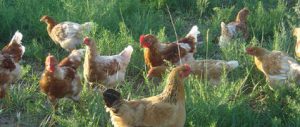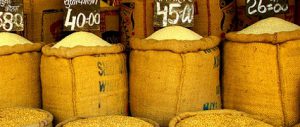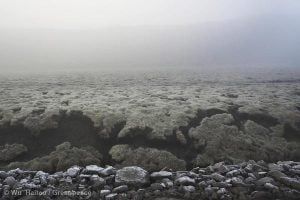This article was first published by Circle of Blue. It is used here with permission.
At an average altitude of 2,350 metres, Colorado’s San Luis Valley, in the western United States, is the nation’s highest agricultural region and one of its top potato producers. Almost by definition, water dictates the patterns of life and land.
With it, valley farmers have turned this sunny, high-desert rift into one of the most densely irrigated expanses of farmland on the planet. Soon, though, a confrontation between rising global commodity prices, which are pushing production to meet demand, and shrinking water supplies, largely linked to climate change, could cause a number of growers here to do without.
Like heavily irrigated areas in California’s Central Valley, in India’s northern regions and in the North China Plain, the San Luis Valley has a groundwater supply problem. Since government-subsidised electricity arrived in the 1950s, farmers here have readily pumped from the two aquifer systems that soak up snowmelt like a sponge. Now, those decades of withdrawals have combined with recently lower-than-average river flows to affect water-rights holders along the Rio Grande River, which cuts through the valley before eventually becoming the Texas-Mexico border.
Simply put, the San Luis Valley no longer has enough water to support the abundant farm production that is becoming increasingly supercharged by rising prices for the crops grown here.
There may be a way out. Water officials in the region’s six counties are working with the federal government on a voluntary plan that would pay farmers to take land out of production. If things turn out as planned, up to 16,000 hectares of the valley’s roughly 240,000 irrigated hectares will not be farmed.
Though it is still being negotiated, the plan has a significant obstacle: the explosive rise in food prices, which are making the sums offered by the water-conservation programme less enticing. Prices for the valley’s mainstay – potatoes – have increased 25% in the last five years. Wheat, alfalfa and barley prices have done even better, more or less doubling over the same period.
“The commodity markets are going to drive this,” said Steve Vandiver, general manager of the Rio Grande Water Conservation District, in an interview with Circle of Blue. “If prices stay high, it’s going to be harder to get farmers to sign up.”
If the voluntary programme does not work, Vandiver went on to say, the result would be worst for farmers. The state, he said, would then step in – like it did in not long ago in the nearby South Platte Basin – and force well owners to shut down, without compensation.
Living on a borrowed resource
Viewed from above, the San Luis Valley is a punch card of tightly packed centre-pivot sprinklers that can pump four cubic metres of water per minute. Settlers started farming the valley in the 1850s and, by 1903, all of the available surface water had been claimed. Because the valley receives so little rain – just 75 millimetres more in a year than what the desert city of Las Vegas receives – everything is irrigated.
Years ago, farmers relied on groundwater, only to finish off the last weeks of the irrigation season, when surface flows were dwindling. But for the last two decades, surface flows in the Rio Grande have declined in comparison with the historical average, said Mike Gibson, manager of the San Luis Valley Water Conservancy District. To make up for the shortage, farmers have pumped groundwater to take up the slack.
Climate change plays a role in the new river patterns, Gibson told Circle of Blue. Wind-storms from the deserts in Arizona and New Mexico are more frequent, and they drop dust on the mountain snowpack, which is the primary water source for the valley’s rivers. The warming effect of the dust, combined with higher temperatures, means that the spring-melt has moved several weeks earlier in the year. With a longer dry period in the summer, more groundwater is required to balance the changes in the river.
New reservoirs to store the altered flows are prohibited under a compact between the states of Colorado, New Mexico and Texas, Gibson said, but existing reservoirs are being renovated to maximise their storage capacity.
Vandiver said that the valley is millions of cubic metres shy of sustainable water levels in the aquifer systems. Each year, roughly 615 million cubic metres are pumped to produce the bounty of alfalfa, barley, potatoes and leafy greens that contribute nearly 40% of the valley’s economy.
The water district banned new wells in the deep aquifer in 1972 and in the shallow aquifer in 1981 – but the over-pumping persists. The district is still developing groundwater models to determine how much of the annual deficit needs to be paid back.
“We have a huge economy here, based on a resource that doesn’t exist,” said George Whitten, president of the Rio Grande Water Conservation District. Whitten’s family has owned Blue Range Ranch since 1897, and he believes that, at the current rate, the agriculture-based economy and the water won’t last much longer.
Project fallow
The valley’s water agencies are working with the US Department of Agriculture’s Farm Services Agency to approve an incentive programme that would pay farmers to leave their land fallow. The incentive is authorised by the Conservation Reserve Enhancement Program (CREP), which was enacted by Congress in 1997 to improve water conservation, wildlife habitat and soils.
The Farm Services Agency runs water conservation CREPs in the states of Colorado, Idaho, Kansas, Nebraska and Oregon. The agency spent US$164 million (1 billion yuan) on CREP payments nationwide during the 2010 fiscal year.
The Republican River Basin is the only CREP programme currently in Colorado, and it began in 2006 with a goal of fallowing 14,000 hectares. But high crop prices have proven to be an impediment in Colorado and in other states – as of October, the programme had enrolled less than 60% of that target area.
Under the San Luis Valley plan, farmers would sign a 15-year contract to take land out of production. They would receive an annual payment per acre, based on local land rates. Valley water officials are asking the federal government for an annual average of US$370 (2,336 yuan) per hectare.
In addition, the local government must provide at least 20% of the programme cost. The Rio Grande Water Conservation District is meeting this requirement by levying a “pumping fee” of between US$35 (221 yuan) and US$60 (378 yuan) per 1,000 cubic metres on farmers who pump groundwater in excess of their surface water right. The fees are charged to irrigators in Subdistrict No. 1, a patch of land north of the Rio Grande, where the aquifer is most depleted and where the fallowing would occur. A smaller administrative fee is also charged to all irrigated land.
Valley officials hope the plan will be approved in time for this year’s irrigation season, but they cannot foresee how its effects will ripple through the community. “We don’t know what the economic and social impacts will be from taking tens of thousands of acres out of agricultural production,” Gibson said.
And if the goals of the management plan are not met, the state is waiting in the wings to enforce the limits with mandatory restrictions. The state engineer, who oversees water rights, will present draft rules to the state supreme court this year.
So, in essence, those farming in the depleted section of the aquifer have to ask themselves this question: if we pass up the land-fallowing deal and continue reaping jackpot harvests, can we find the surface water offsets that the state could require?
Karla Shriver, who for 26 years has grown potatoes on 400 hectares south of the Rio Grande, believes more people will take the payments rather than leave it to chance. She told Circle of Blue that, looking long term, the CREP money may be the best offer that farmers could get.
“We can’t maintain high prices forever,” Shriver said. “It’s all cyclical.”
The sun and the water
Because the area gets an average of 340 days of sunshine per year, the San Luis Valley is at the center of solar-power development in the western United States. The Bureau of Land Management has put four parcels of land it manages on the “fast-track” for regulatory approval, and several investor-owned companies are already operating in the valley.
If hectares of silicon panels were to replace irrigated crops on worn-out land, this solar industrialisation could also help the water problem. But solar jobs are not farm jobs, and valley residents have pushed back against large solar projects. Besides, farming has been not just a way of life, but life itself here for the last 150 years.
“Agriculture is our economy in the valley,” said Vandiver. “If it goes away, we have nothing left.”
Brett Walton is a Seattle-based reporter for Circle of Blue. Part of the reporting for this story was done while he participated in a fellowship that was paid for by the Institutes for Journalism and Natural Resources.
Homepage image by Doc Searls


